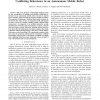Free Online Productivity Tools
i2Speak
i2Symbol
i2OCR
iTex2Img
iWeb2Print
iWeb2Shot
i2Type
iPdf2Split
iPdf2Merge
i2Bopomofo
i2Arabic
i2Style
i2Image
i2PDF
iLatex2Rtf
Sci2ools
106
Voted
CEC
2009
IEEE
2009
IEEE
A multiple hormone approach to the homeostatic control of conflicting behaviours in an autonomous mobile robot
This work proposes a biologically inspired system for the coordination of multiple and possible conflicting behaviours in an autonomous mobile robot, devoted to explore novel scenarios while ensuring its internal variables dynamics. The proposed Evolutionary Artificial Homeostatic System, derived from the study of how an organism would self-regulate in order to keep its essential variables within a limited range (homeostasis), is composed of an artificial endocrine system, including two hormones and two hormone receptors, and also three previously evolved NSGasNet artificial neural networks. It is shown that the integration of receptors enhance the system robustness without incorporating to the three evolved NSGasNets more a priori knowledge. The experiments conducted also show that the proposed multi-hormone evolutionary artificial homeostatic system is able to successfully coordinate a multiple and conflicting behaviours task, being also robust enough to cope with internal and extern...
Artificial Homeostatic System | Artificial Intelligence | CEC 2009 | Conflicting Behaviours | Possible Conflicting Behaviours |
| Added | 16 Feb 2011 |
| Updated | 16 Feb 2011 |
| Type | Journal |
| Year | 2009 |
| Where | CEC |
| Authors | Renan C. Moioli, Patrícia Amâncio Vargas, Phil Husbands |
Comments (0)

